|


The Experiences
Experience The Experience Of Being
Buried Alive (June 14/8 PM: Los
Angeles, June 30/8 PM: Vancouver, July 8/7 PM: San Francisco)
Experience
The Experience Of An Illegal Space Race
(June 25/ 2 PM: Los Angeles)
Experience
The Experience Of Growing Money
(July 14/ 8 PM: San Francisco)
Experience
The Experience Of A Magnetism Party
(June 18/8 PM, Los Angeles)
Experience The Experience Of Catapulting Wireless
Devices (Workshop: July 9/6 PM; Event: July 16/2 PM, San Francisco)
Experience The Experience Of A Brick Of Coke
(June 21/8 PM: Los Angeles)
Experience The Experience Of 1 Baud
(Workshop: July 20/6 PM; Event: July 22/5 PM: San Francisco) |
|
|
Experience The Experience Of A Brick Of Coke
|
Sugar has always been expensive enough that in a variety of cultures and eras it has even been used as a medium of exchange. In Europe sugar was first introduced around the year 600, and it reached England via the Mediterranean region in the 11th century - of course as a luxury good reserved for the ruling class. The first recorded delivery of slaves (to Lagos, Portugal in 1444) was intended for sugar cultivation on Portugal's Atlantic islands. In order to provide sufficient "personnel" for the colonies overseas, the slave trade was promoted intensively. Sugar was in part responsible for the development of the gigantic preindustrial bureaucratic mercantile system of "prosperity." Refined white sugar was the symbol of European conquest and of century-long repression and colonial dependency. Sugar still dominates the Western meal plan as the main energy provider. The "former" tropical colonies are still ruled by the multinational concerns of the sugar industry. Coca Cola is the largest seller on the world market. monochrom is going to put several gallons of Coca Cola into a pot and boil it down until the residue left behind can be molded into a brick. A symbolic endeavor!
Los Angeles (Machine Project): June 21, 8 PM.
|
Day 7 / Revelation
June 21. Evening.
The talk.
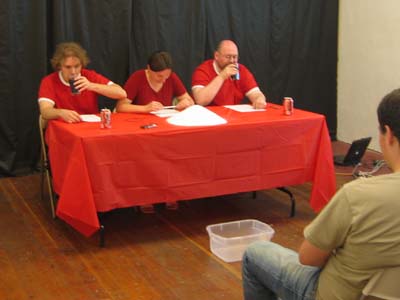
[...]
(Gargling.)
[...]
A sugar is a form of carbohydrate used in the food and drinks industries, and important in biochemistry. Sucrose (also called saccharose), a white crystalline solid, is the most commonly used sugar for altering the flavor and properties ('mouthfeel', preservation, texture) of beverages and food. The "simple" sugars, such as glucose (which is produced from sucrose by enzymes or acid hydrolysis), are a store of energy which is used by biological cells.
In culinary terms, sugar is a type of food associated with one of the primary taste sensations, that of sweetness.
[...]
(Gargling.)
[...]
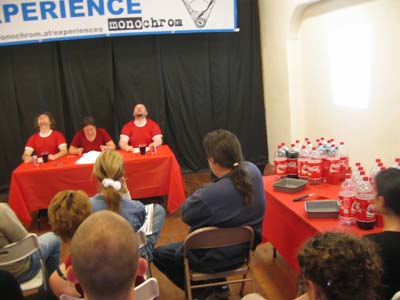
[...]
(Gargling.)
Sweets for my sweet, sugar for my honey, I'll never ever let you go.
(Gargling.)
[...]
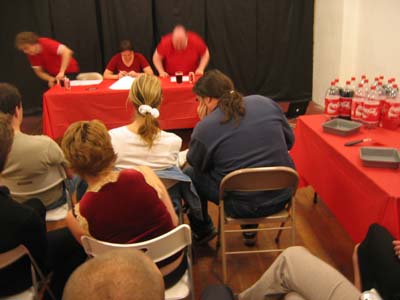
[...]
(Gargling.)
[...]
Coca-Cola in the US is made with corn syrup, not sugar.
Why?
One of the triumphs of American agribusiness is the ability to produce cheap calories. For example, in the seventies American corn production increased sharply. In 1971 a group of Japanese food scientists discovered a way to economically make a sweetener called high fructose corn syrup - six times sweeter than regular sugar (sucrose) and less expensive than sucrose. HFCS is a wonder. It is cheap. Using it in frozen foods protects against freezer burn. Using it in long shelf life foods (vending machine products) keeps the product fresh tasting. Using it in bakery products makes them look more natural. It also has, it turns out, a downside. It seems that fructose is metabolized differently than sucrose and dextrose. Sucrose and dextrose are broken down before they arrive at the liver; fructose goes directly to the liver where it is used a building block for triglycerides. In consequence fatty acids are released into the bloodstream. With enough fatty acids in the bloodstream muscle tissue develops insulin resistance - the precursor to type II diabetes.
9 percent of the average person's calories come from fructose; 20 percent of the average child's calories come from fructose.
Even more fun - fructose plays hob with the enzymes that "tell" cells whether to burn fat or store it. Fat is stored more readily in high fructose diets.
Good stuff. It is to die for.
[...]
(Gargling.)
[...]
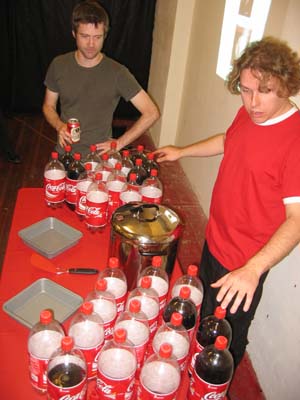
"We want the brick!" - "They want the brick!"
"We want the brick!" - "They want the brick!"
Ok, ok. One last rant before the brick!
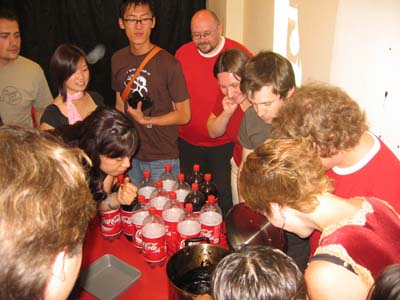
Johannes lifts the lid and reveals the substance.
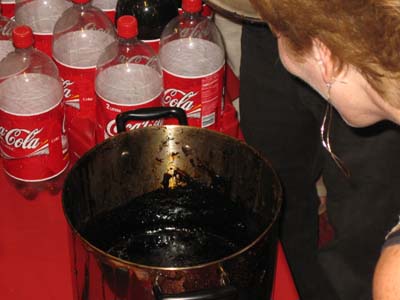
The crowd is stunned.
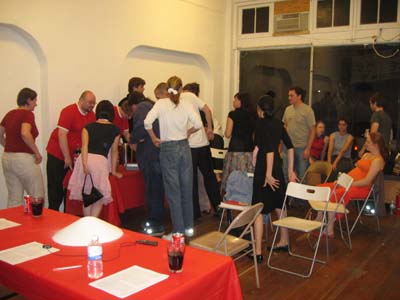
We draw samples.
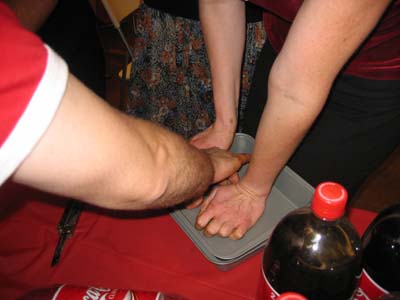
We start to extract Coke tar and mold it into the cake form.
It is an exhausting task.
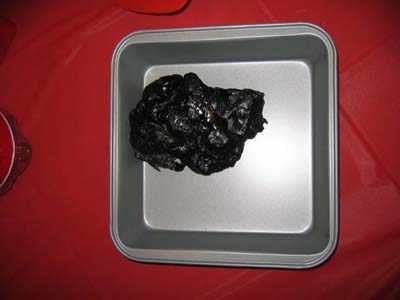
We desperately need the three volunteers who are eager to provide us with tools (Leatherman) and all the enthusiasm they can spare.
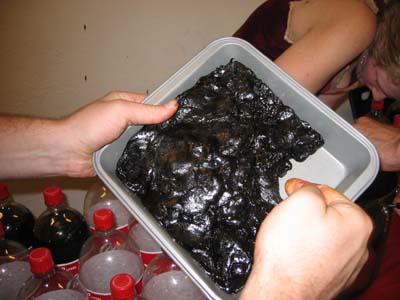
Nobody complains of hardship, although Johannes gets a huge blister on his finger.
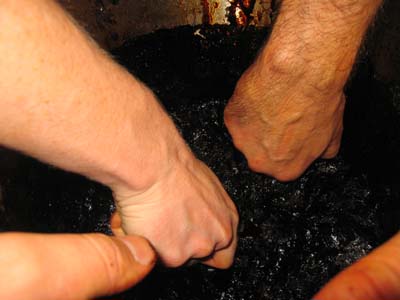
After 45 minutes the form is finally full.
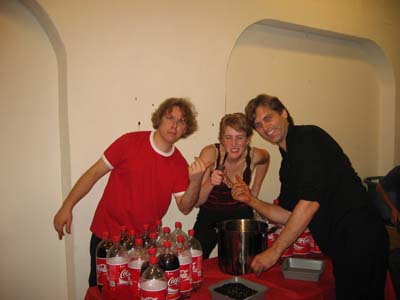
Johannes presents the brick to the world.
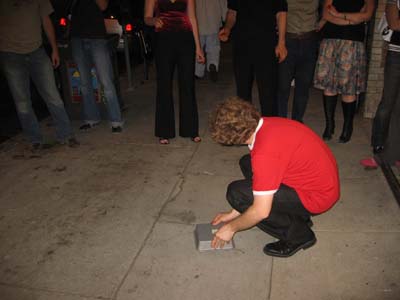
The real thing.
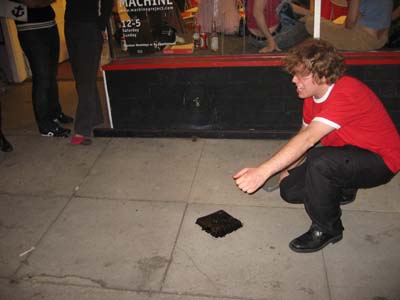
(Thanks, teflon pan.)
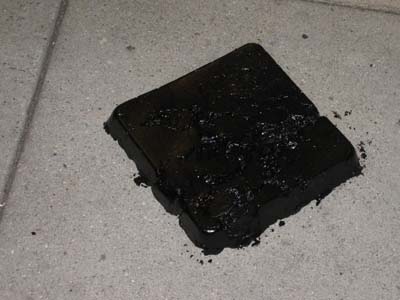
The touching procedure can begin.
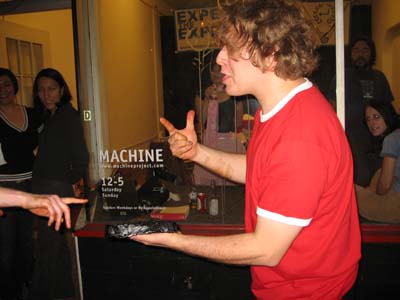
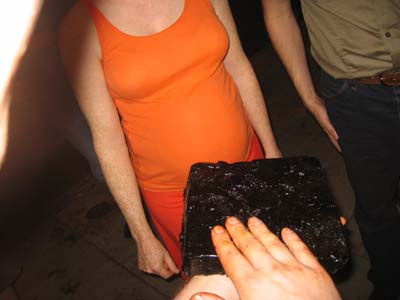
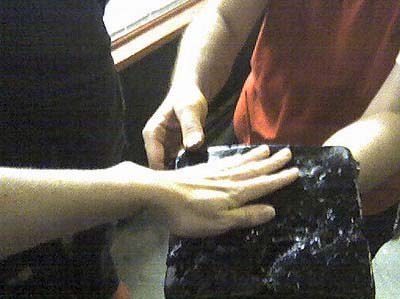
Johannes puts the brick back in the protection form and places it on top of our small hill of sugar.
Evelyn, Johannes and Günther sing a song for the brick... and the crowd joins in.I'd like to build the world a home
And furnish it with love
Grow apple trees and honey bees
And snow-white turtle doves
I'd like to teach the world to sing
In perfect harmony
I'd like to hold it in my arms
And keep it [Coca Cola] company 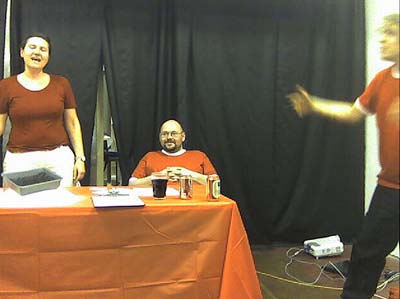
The visitors are excited about getting a certificate.
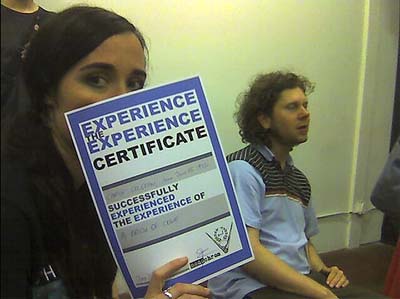
It officially confirms that they 'Experienced The Exprience Of A Brick Of Coke'.
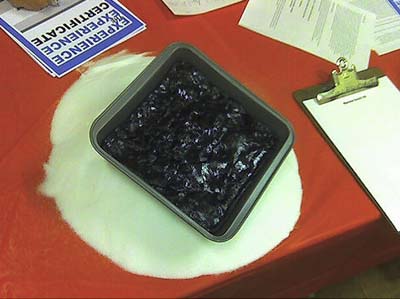
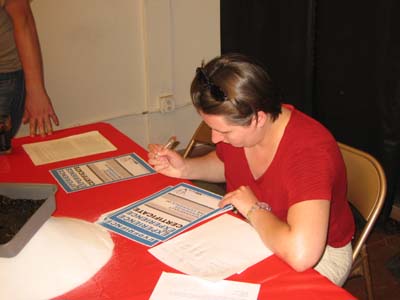
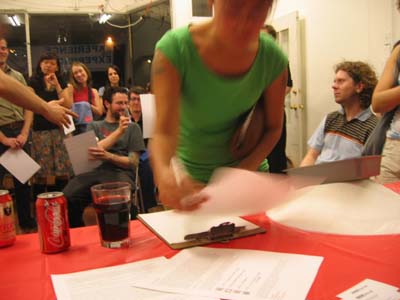
We decide to keep the brick rather than rehydrating it, and to ship it to Austria. May it serve generations to come as an example of the miracles mankind is capable of.
[posted by johannes at
12:36 PM]
Day 7 / Last boiling phase
June 21. Morning.
Difficulties with Coke tar worsen.
We constantly stir the substance at low heat but the molasses soup is highly dangerous.
Pre-eruption picture.
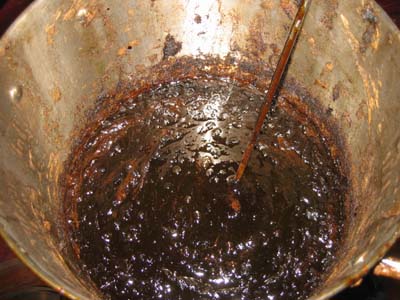
Suddenly a geyseric fountain of Coke bursts out of the pot...
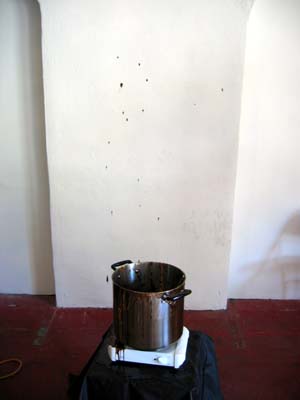
Hot Coke blobs spray onto the wall at a distance of 7 feet and a height of 5.5 feet.
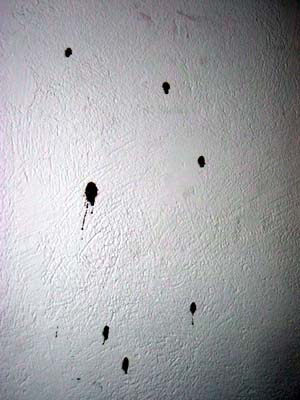
Safety counter measurements.
We put the heating plate and the pot on the floor and span black foil over it.
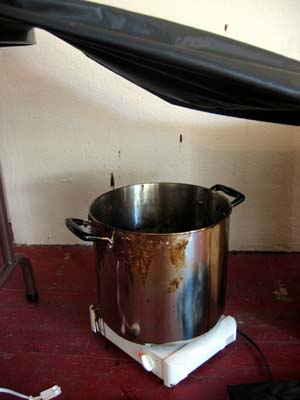
Safety counter measurements don't work.
June 21. Afternoon.
Mark suggests to put a cardbox on top of the pot.
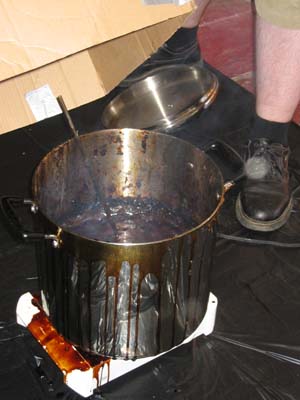
We feel safer.
We punch holes into the cardbox.
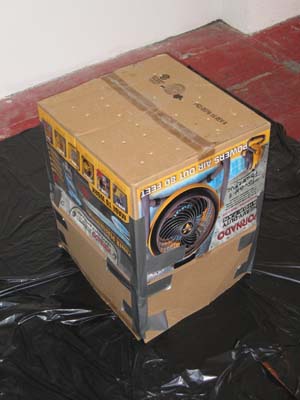
From time to time we lift the box and stir.
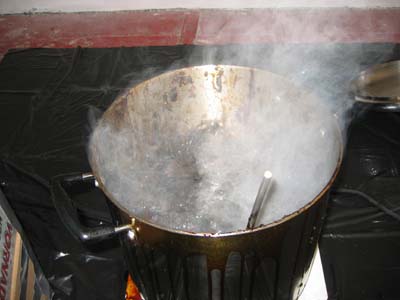
June 21. Late afternoon.
Preparations for the presentation.
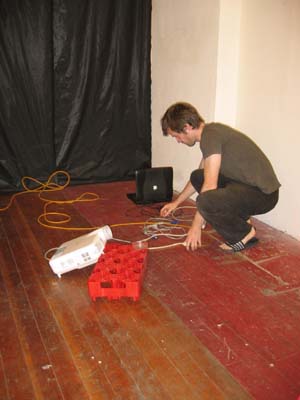
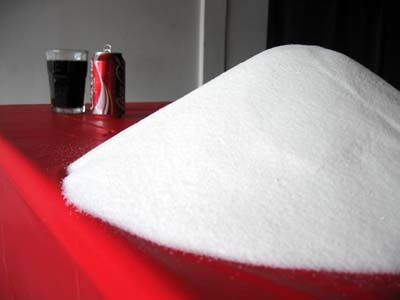
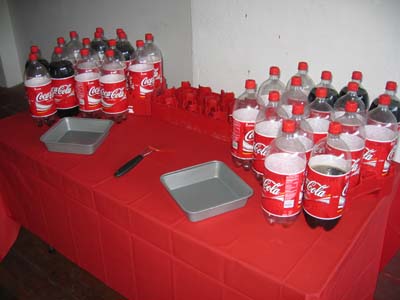
[posted by johannes at
11:50 AM]
Day 6
June 20. Afternoon.
21 bottles so far.
Texture gets more and more viscous.
Bubble problems occur.
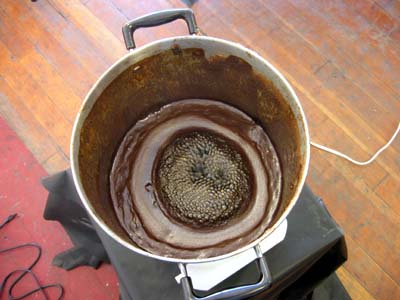
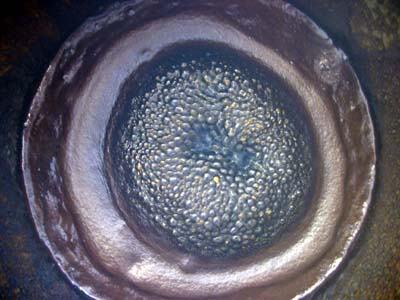
Overboil alert.
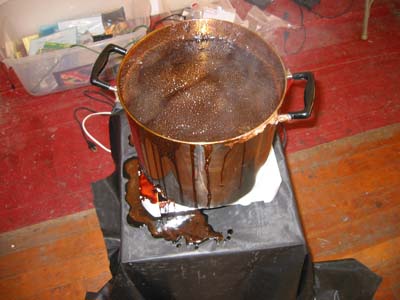
Post-overboil AVI.
June 20. Evening.
We buy:
1 Oxo SoftWorks Nylon Flexible Turner
2 Chefmate 8" Cake Pans
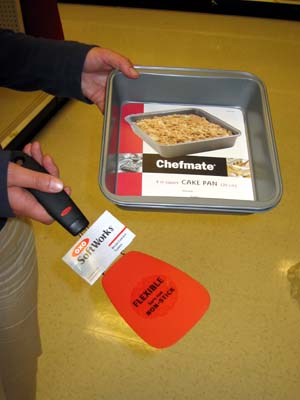
[posted by johannes at
10:47 PM]
Day 5
June 19. Midday.
We receive a nice email from Lillie K.:
I love your project; excellent meta-surrealism.
Someone's probably pointed this out already, but I thought I would give you a heads-up just in case: Coca-Cola in the US is made with corn syrup, not sugar. (Due to artificially high sugar prices, and artificially low corn prices.)
Keep up the weird work!
-Lillie
Thanks a lot for the compliment.
And we are aware that Coca Cola is using high fructose corn syrup in its US products. Still, the Coca Cola Company is the biggest sugar processing entity on the surface of the planet. By the way... the Coke level in our pot is very low at the moment...have to replenish it. Be right back.
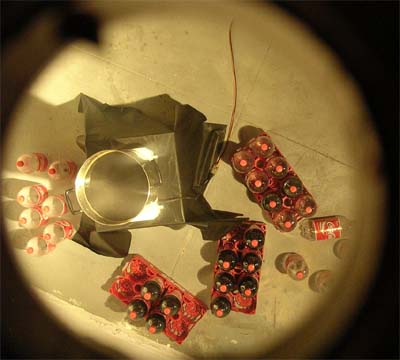
[posted by johannes at
1:30 PM]
Day 4
June 18.
Double, double toil and trouble, heater heat, and cauldron bubble.
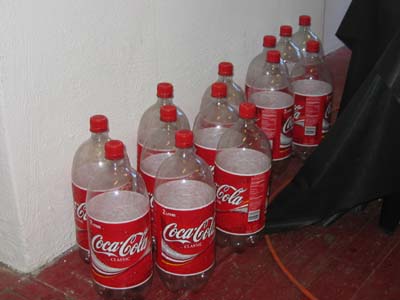
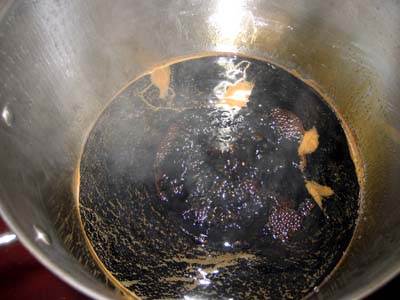
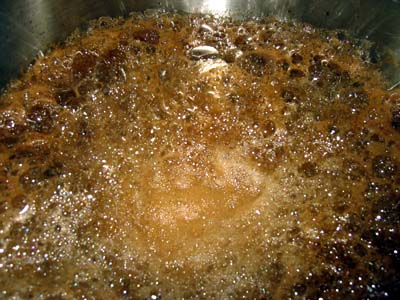
[posted by johannes at
11:33 AM]
Day 3
June 17.
Free refill.
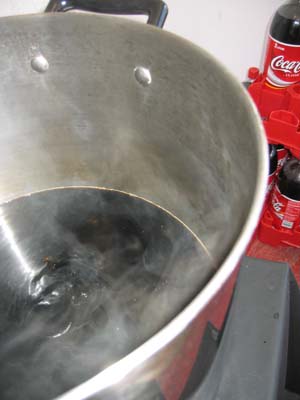
[posted by johannes at
12:46 PM]
Day 2 / At the outset
June 15. Evening.
First four bottles.
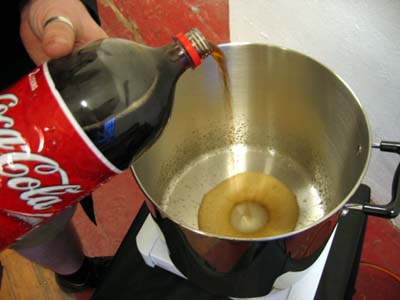
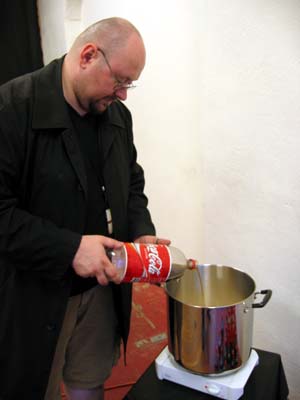
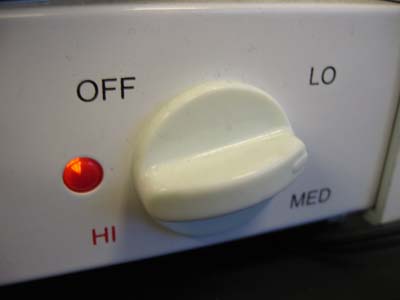
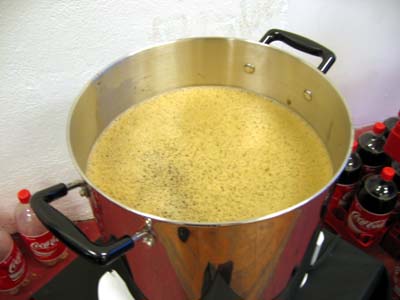
[posted by johannes at
11:59 AM]
Day 1 and 2 / Preparations
June 14. Afternoon.
We find a heating plate at Machine Project Gallery.
June 15. Afternoon.
We support the US economy and buy a Rangeware Stainless Steel 16 quarts cooking pot at Glendale Galleria, LA.
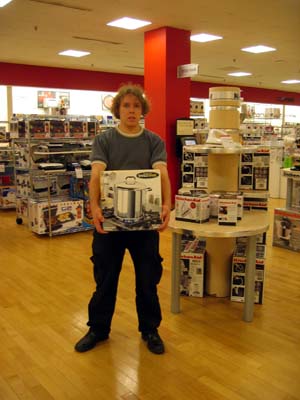
We set up the boiling site.
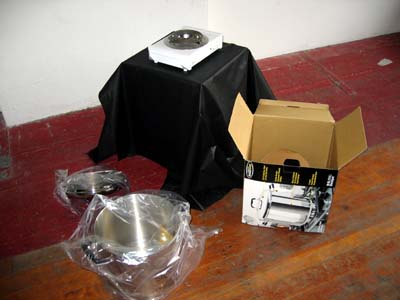
We buy the first 16 gallons of Coke.
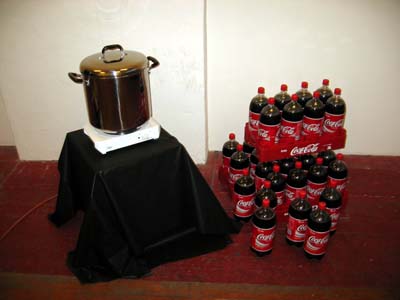
[posted by johannes at
6:50 PM]
We're in the mood to vent: The topic is sugar.
In the form of a bitchy little cultural history.
Sugar cane, which original came from the South Pacific, was first used agriculturally in India about two thousand years ago. To this day, it is still found in the myths and legends handed down in this region. The Polynesian "Eva" was a woman who sprang from a sugar cane, while in India, Ishvaku, the son of Manu (the father of humanity) was found in a sugar cane field. The scion of the hundredth generation of this sugar cane dynasty was Gautama, the Buddha. Sugar was seen as a crystalline form of power, as a sort of distilled solar energy. In heathen Europe, the equivalent of sugar cane was honey, the symbol of purity, and in early Christianity this symbol was used in the rite of baptism, also on account of its rarity. Sugar was precious enough that in a diversity of cultures during various eras it even functioned as a medium of exchange. In Europe, sugar was first introduced around 1600, eventually reaching England via the Mediterranean - of course as a luxury good for the ruling class. Elizabeth I (1558-1605) was known for her black teeth, rotten from excessive sugar consumption. Sugar gave - as many nutrition researchers claim - the Europeans a veritable burst of energy comparable to today's cocaine consumption, and according to this theory, it was in part responsible for this continent's colonial expansionism.
Initially sugar cane was planted in the "New World" (see Columbus, 1492). The first registered shipment of slaves (to Lagos, Portugal, 1444) was intended for sugar cultivation on the Atlantic islands off the coast of Portugal. The slave trade was intensively promoted in order to supply enough "personnel" for the expanding plantations in the overseas colonies. Due to the pest and other imported diseases, the indigenous population needed to carry out the work was decimated to such a degree that sugar production fell way behind schedule. Many of the Caribbean Islands were converted into plantation islands to keep up with the continuously rising demand in Europe. Additional African regions were annexed and the slave trade boomed.
Sugar was in part responsible for the evolution of the gigantic bureaucratic and mercantile pre-industrial prosperity and thus was also one of the key factors in the development of capitalist structures. Refined white sugar was the symbol of European conquest and of the century-long subjugation and dependence into which the rest of the world was thrown. Today the sugar industry has a turnover of 130 million metric tons per year. The "former" tropical colonies are dominated by the multinationals of the sugar business. Coca-Cola is the largest sugar customer on the world market.
Sugar dominates the Western meal plan as the main substance of energy acquisition and contributes (in addition to salt, which is only used in cooking and which has been replaced by flavor enhancers) to disguising the tastelessness of industrial foodstuffs and soft drinks. Since the growth of "health awareness" in the "First World", large quantities of sugar and fat have been exported to Asia, South America and Africa at dumping prices. This strategy is primarily intended to divert the flow of capital and to establish new markets (something which has also occurred with tobacco products). It remains to be seen how the efforts of organizations and health authorities will fair against the PR budgets of the luxury food industry (sugar is not a foodstuff but a luxury article, as a Third World Shop working group has established).
Hail, hail tooth decay! Hail, hail cancer! Hail, hail ulcerative colitis!
[posted by johannes at
9:25 AM]
Experience The Experience Of A Brick Of Coke

[posted by johannes at
2:11 AM]
|